mysql基础之DQL基本单表查询
学习DQL之前先知道sql语句的执行顺序
from->join->on->where->group by->count(字段)->having->select->distinct->order by->limit
注意 在mysql8.0中 having可以使用select后面的别名
2. null无法和任何值进行比较(不相等),包括null和null也不相等
1.DQL简单查询
- 数据库管理系统一个重要功能就是数据查询,数据查询不应只是简单返回数据库中存储的数据,还应该根据需要对数据进行筛选以及确定数据以什么样的格式显示。
- MySQL提供了功能强大、灵活的语句来实现这些操作。
- MySQL数据库使用select语句来查询数据。
1.1语法格式
select
[all|distinct]
<目标列的表达式1> [别名],
<目标列的表达式2> [别名]...
from <表名或视图名> [别名],<表名或视图名> [别名]...
[where<条件表达式>]
[group by <列名>
[having <条件表达式>]]
[order by <列名> [asc|desc]]
[limit <数字或者列表>];
简化版语法
select *| 列名 from 表 where 条件
1.2. 数据准备
- 创建数据库和表
-- 创建数据库
create database if not exists mydb2;
use mydb2;
-- 创建商品表:
create table product(
pid int primary key auto_increment, -- 商品编号
pname varchar(20) not null , -- 商品名字
price double, -- 商品价格
category_id varchar(20) -- 商品所属分类
);
- 添加数据
insert into product values(null,'海尔洗衣机',5000,'c001');
insert into product values(null,'美的冰箱',3000,'c001');
insert into product values(null,'格力空调',5000,'c001');
INSERT INTO product VALUES(NULL,'九阳电饭煲',200,'c001');
insert into product values(null,'啄木鸟衬衣',300,'c002');
insert into product values(null,'恒源祥西裤',800,'c002');
insert into product values(null,'花花公子夹克',440,'c002');
insert into product values(null,'劲霸休闲裤',266,'c002');
insert into product values(null,'海澜之家卫衣',180,'c002');
insert into product values(null,'杰克琼斯运动裤',430,'c002');
insert into product values(null,'兰蔻面霜',300,'c003');
insert into product values(null,'雅诗兰黛精华水',200,'c003');
insert into product values(null,'香奈儿香水',350,'c003');
insert into product values(null,'SK-II神仙水',350,'c003');
insert into product values(null,'资生堂粉底液',180,'c003');
insert into product values(null,'老北京方便面',56,'c004');
insert into product values(null,'良品铺子海带丝',17,'c004');
insert into product values(null,'三只松鼠坚果',88,null);
- 简单查询
-- 1.查询所有的商品.
select * from product;
-- 2.查询商品名和商品价格.
select pname,price from product;
-- 3.别名查询.使用的关键字是as(as可以省略的).
-- 3.1表别名:
select * from product as p;
-- 3.2列别名:
select pname as pn from product;
-- 4.去掉重复值.
select distinct price from product;
-- 5.查询结果是表达式(运算查询):将所有商品的价格+10元进行显示.
select pname,price+10 from product;
2.DQL语句中运算符操作
简介
数据库中的表结构确立后,表中的数据代表的意义就已经确定。通过MySQL运算符进行运算,就可以获取到表结构以外的另一种数据。
例如,学生表中存在一个birth字段,这个字段表示学生的出生年份。而运用MySQL的算术运算符用当前的年份减学生出生的年份,那么得到的就是这个学生的实际年龄数据。
MySQL支持4种运算符
- 算术运算符
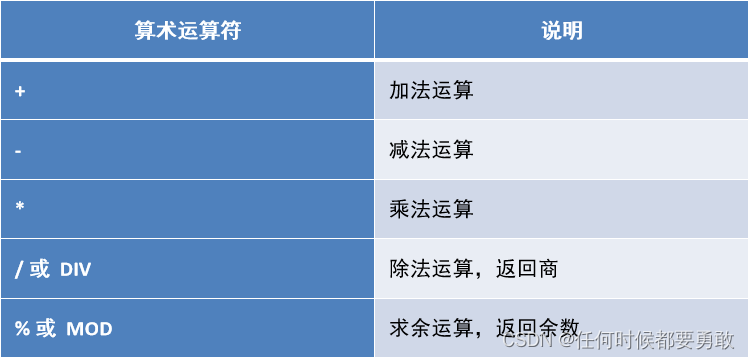
案例
select 6 + 2;
select 6 - 2;
select 6 * 2;
select 6 / 2;
select 6 % 2;
-- 将每件商品的价格加10
select name,price + 10 as new_price from product;
-- 将所有商品的价格上调10%
select pname,price * 1.1 as new_price from product;
- 比较运算符
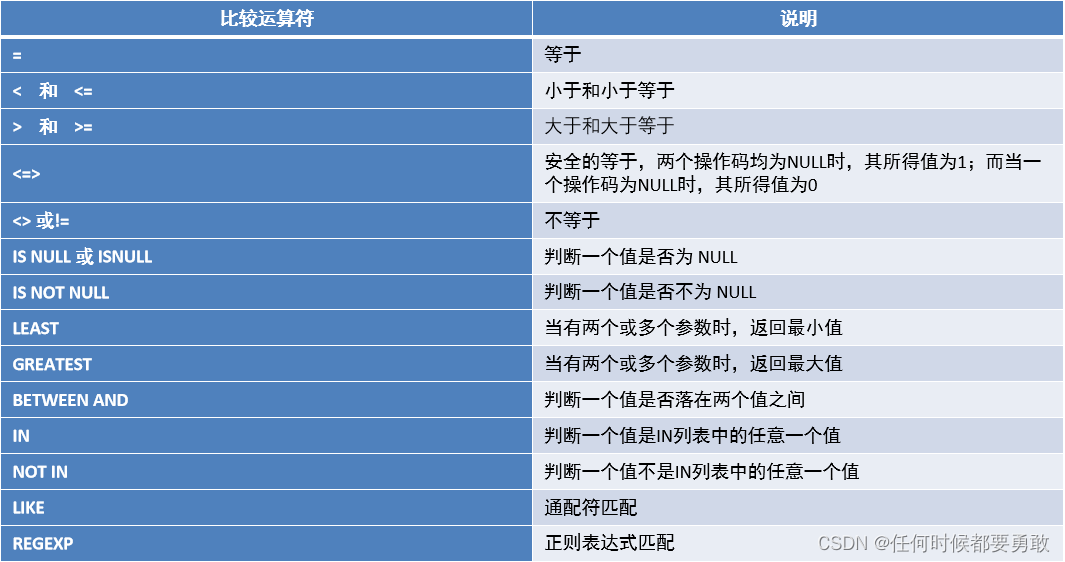
案例
-- 查询商品名称为“海尔洗衣机”的商品所有信息:
select * from product where pname = '海尔洗衣机';
-- 查询价格为800商品
select * from product where price = 800;
-- 查询价格不是800的所有商品
select * from product where price != 800;
select * from product where price <> 800;
-- 逻辑运算符逻辑非
select * from product where not(price = 800);
-- 查询商品价格大于60元的所有商品信息
select * from product where price > 60;
-- 查询商品价格在200到1000之间所有商品
select * from product where price >= 200 and price <=1000;
select * from product where price between 200 and 1000;
-- 查询商品价格是200或800的所有商品
select * from product where price = 200 or price = 800;
select * from product where price in (200,800);
-- 查询含有‘裤'字的所有商品
select * from product where pname like '%裤%';
-- 查询含有‘海'字的所有商品
select * from product where pname like '%海%';
-- 查询第二个字为'蔻'的所有商品
select * from product where pname like '_蔻%';
-- 查询category_id为null的商品
select * from product where category_id is null;
-- 查询category_id不为null分类的商品
select * from product where category_id is not null;
-- 使用least求最小值
select least(10, 20, 30); -- 10
--如果求最小值时,有个值为null,则不会进行比较,结果直接为nu1l;
select least(10, null , 30); -- null
-- 使用greatest求最大值
select greatest(10, 20, 30);
-- --如果求最大值时,有个值为null,则不会进行比较,结果直接为nu1l;
select greatest(10, null, 30); -- null
-
逻辑运算符
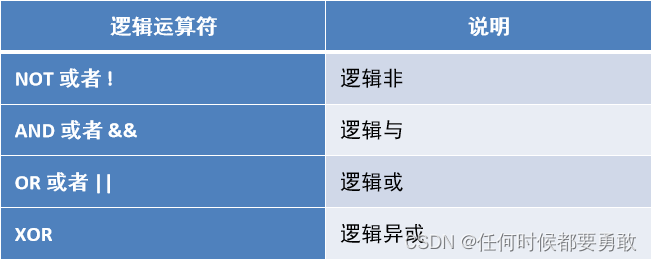
-
位运算符

位运算符是在二进制数上进行计算的运算符。位运算会先将操作数变成二进制数,进行位运算。然后再将计算结果从二进制数变回十进制数。
select 3&5; -- 位与 都为1则为1
select 3|5; -- 位或 一个为1则为1
select 3^5; -- 位异或 不同则为1相同则为0
select 3>>1; -- 位左移
select 3<<1; -- 位右移
select ~3; -- 位取反
3.排序查询 order by
1. 介绍
如果我们需要对读取的数据进行排序,我们就可以使用 MySQL 的 order by 子句来设定你想按哪个字段哪种方式来进行排序,再返回搜索结果。
2. 语法
select
字段名1,字段名2,……
from 表名
order by 字段名1 [asc|desc],字段名2[asc|desc]……
3. 特点
①asc代表升序,desc代表降序,如果不写默认升序
②order by用于子句中可以支持单个字段,多个字段,表达式,函数,别名
③order by子句,放在查询语句的最后面。LIMIT子句除外
④如果order by后边跟一个字段,则只会按照该字段的值进行排序,该字段必须为数值类型或者英文和数字字符串类型(‘beijing’)或者“2020-12-23”
⑤ 如果order by后边跟多个字段:order by c1,c2
解释:先安装c1来排序,如果c1相同,则按照c2来排
4. 操作
-- 1.使用价格排序(降序)
select * from product order by price desc;
-- 2.在价格排序(降序)的基础上,以分类排序(降序)
select * from product order by price desc,category_id asc;
-- 3.显示商品的价格(去重复),并排序(降序)
select distinct price from product order by price desc;
第二条sql语句结果如下优先按照price降序,当价格相等时按照category_id升序
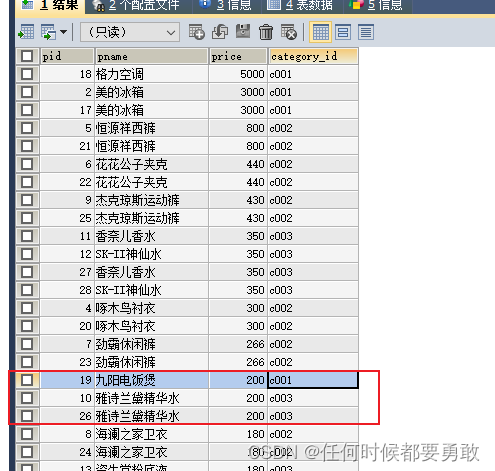
4.聚合查询
4.1聚合函数
1. 简介
之前我们做的查询都是横向查询,它们都是根据条件一行一行的进行判断,而使用聚合函数查询是纵向查询,它是对一列的值进行计算,然后返回一个单一的值;另外聚合函数会忽略空值。
2. 函数
count()查看某列或者某张表的行数

注意:
count(pid) 如果列有null值则不会进行统计
sum(price),max(price),min(price),avg(price) 如果列有null值则不会进行统计,当作不存在,列必须为数值列
3. 操作
-- 1 查询商品的总条数
select count(*) from product;
-- 2 查询价格大于200商品的总条数
select count(*) from product where price > 200;
-- 3 查询分类为'c001'的所有商品的总和
select sum(price) from product where category_id = 'c001';
-- 4 查询商品的最大价格
select max(price) from product;
-- 5 查询商品的最小价格
select min(price) from product;
-- 6 查询分类为'c002'所有商品的平均价格
select avg(price) from product where category_id = 'c002';
聚合函数一般会和分组一起使用
4.2 聚合函数,NULL值的处理
1. 介绍
1、count函数对null值的处理
如果count函数的参数为星号(*),则统计所有记录的个数。而如果参数为某字段,不统计含null值的记录个数。
2、sum和avg函数对null值的处理
这两个函数忽略null值的存在,就好象该条记录不存在一样。
3、max和min函数对null值的处理
max和min两个函数同样忽略null值的存在。
2. 操作
-- 创建表
create table test_null(
c1 varchar(20),
c2 int
);
-- 插入数据
insert into test_null values('aaa',3);
insert into test_null values('bbb',3);
insert into test_null values('ccc',null);
insert into test_null values('ddd',6);
-- 测试
select count(*), count(1), count(c2) from test_null; -- count(1)等价于count(*)
select sum(c2),max(c2),min(c2),avg(c2) from test_null;
5.分组查询 group by 和having
5.1 group by 分组
1. 简介
分组查询是指使用group by字句对查询信息进行分组。
2. 格式:
select 字段1,字段2… from 表名 group by 分组字段 having 分组条件;
3. 操作
-- 1 统计各个分类商品的个数
select category_id ,count(*) from product group by category_id ;
4. 注意点
-
分组可以理解为将一张表临时拆分成多张表,拆分的依据就是分组字段
-
如果要进行分组的话,则SELECT子句之后,只能出现分组的字段和聚合函数,其他的字段不能出现:
-
分组可以根据一个字段,也可以根据多个字段,如果是一个字段则该字段相同就会分到同一组,如果是多个字段,则多个字段都相同才能分到同一组
如果group by后面跟了多个字段如下,则必须是同一个省同一个市同一个县才可以分到一组,省市县可以不区分先后顺序

5.2 分组之后的条件筛选-having
1. 简介
- 分组之后对统计结果进行筛选的话必须使用having,不能使用where
- where子句用来筛选 FROM 子句中指定的操作所产生的行
- group by 子句用来分组 WHERE 子句的输出。
- having 子句用来从分组的结果中筛选行
2. 格式
select 字段1,字段2… from 表名 group by 分组字段 having 分组条件;
3. 操作
--.统计各个分类商品的个数,且只显示个数大于4的信息
select category_id ,count(*) from product group by category_id having count(*) > 1;

上述sql语句的执行书讯

6.分页查询-limit
1. 简介
分页查询在项目开发中常见,由于数据量很大,显示屏长度有限,因此对数据需要采取分页显示方式。例如数据共有30条,每页显示5条,第一页显示1-5条,第二页显示6-10条。
2. 格式
-- 方式1-显示前n条
select 字段1,字段2... from 表明 limit n
-- 方式2-分页显示
select 字段1,字段2... from 表明 limit m,n
m: 整数,表示从第几条索引开始,计算方式 (当前页-1)*每页显示条数
n: 整数,表示查询多少条数据
3. 操作
-- 查询product表的前5条记录
select * from product limit 5
-- 从第4条开始显示,显示5条
select * from product limit 3,5
7. 将一张表的数据导入到另一张表中
7.1INSERT INTO SELECT语句
1. 简介
将一张表的数据导入到另一张表中,可以使用INSERT INTO SELECT语句 。
2. 格式
insert into Table2(field1,field2,…) select value1,value2,… from Table1 或者:
insert into Table2 select * from Table1
要求目标表Table2必须存在
7.2 SELECT INTO FROM语句
1. 简介
将一张表的数据导入到另一张表中,有两种选择 SELECT INTO 和 INSERT INTO SELECT 。
2. 格式
SELECT vale1, value2 into Table2 from Table1
要求目标表Table2不存在,因为在插入时会自动创建表Table2,并将Table1中指定字段数据复制到Table2中。
8. 正则表达式查询
1. 介绍
正则表达式(regular expression)描述了一种字符串匹配的规则,正则表达式本身就是一个字符串,使用这个字符串来描述、用来定义匹配规则,匹配一系列符合某个句法规则的字符串。在开发中,正则表达式通常被用来检索、替换那些符合某个规则的文本。
MySQL通过REGEXP关键字支持正则表达式进行字符串匹配。
2. 格式
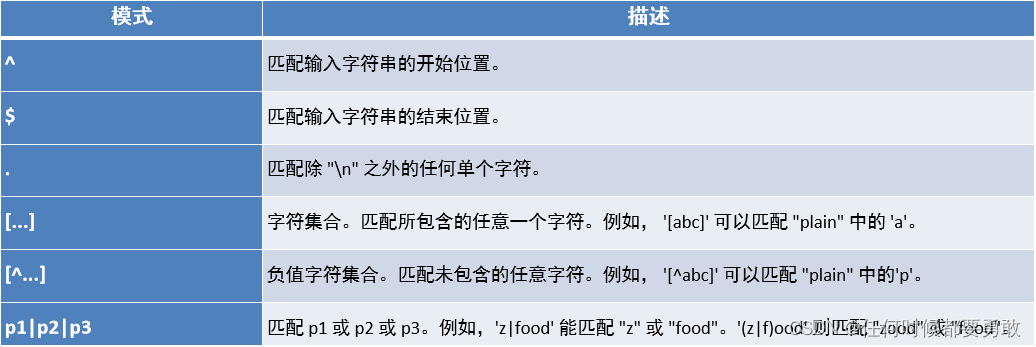

3. 操作
-- ^ 在字符串开始处进行匹配
SELECT 'abc' REGEXP '^a';
-- $ 在字符串末尾开始匹配
SELECT 'abc' REGEXP 'a$';
SELECT 'abc' REGEXP 'c$’;
-- . 匹配任意字符
SELECT 'abc' REGEXP '.b';
SELECT 'abc' REGEXP '.c';
SELECT 'abc' REGEXP 'a.';
-- [...] 匹配括号内的任意单个字符
SELECT 'abc' REGEXP '[xyz]';
SELECT 'abc' REGEXP '[xaz]';
-- [^...] 注意^符合只有在[]内才是取反的意思,在别的地方都是表示开始处匹配
SELECT 'a' REGEXP '[^abc]';
SELECT 'x' REGEXP '[^abc]';
SELECT 'abc' REGEXP '[^a]';
-- a* 匹配0个或多个a,包括空字符串。 可以作为占位符使用.有没有指定字符都可以匹配到数据
SELECT 'stab' REGEXP '.ta*b';
SELECT 'stb' REGEXP '.ta*b';
SELECT '' REGEXP 'a*';
-- a+ 匹配1个或者多个a,但是不包括空字符
SELECT 'stab' REGEXP '.ta+b';
SELECT 'stb' REGEXP '.ta+b';
-- a{m,n} 匹配m到n个a,包含m和n
SELECT 'auuuuc' REGEXP 'au{3,5}c';
SELECT 'auuuuc' REGEXP 'au{4,5}c';
SELECT 'auuuuc' REGEXP 'au{5,10}c';
-- (abc) abc作为一个序列匹配,不用括号括起来都是用单个字符去匹配,如果要把多个字符作为一个整体去匹配就需要用到括号,所以括号适合上面的所有情况。
SELECT 'xababy' REGEXP 'x(abab)y';
SELECT 'xababy' REGEXP 'x(ab)*y';
SELECT 'xababy' REGEXP 'x(ab){1,2}y';
总结
字符串1 regexp 字符串2 没有写限定符(^$)的情况下代表
字符串1 是否包含字符串2
[^…] 注意^符合只有在[]内才是取反的意思,在别的地方都是表示开始处匹配
匹配除了[]的任意一个字符
本文来自互联网用户投稿,该文观点仅代表作者本人,不代表本站立场。本站仅提供信息存储空间服务,不拥有所有权,不承担相关法律责任。 如若内容造成侵权/违法违规/事实不符,请联系我的编程经验分享网邮箱:veading@qq.com进行投诉反馈,一经查实,立即删除!